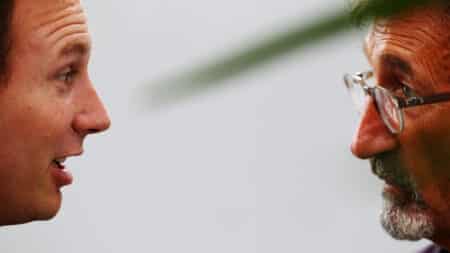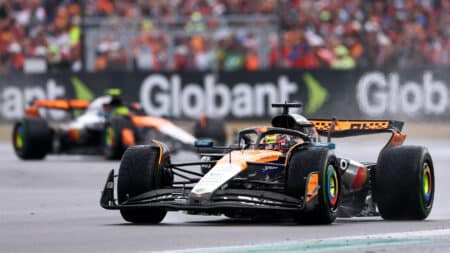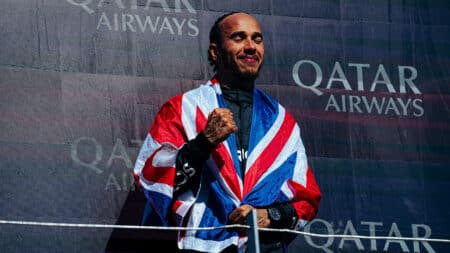
Horner's departure shows age of the maverick F1 boss is over
Christian Horner has now left Red Bull, the last of a certain breed of F1 team principal
I have written quite a lot over the years, but the following words have been by far the hardest I have had to write.

I have decided to retire from professional racing at the end of 2016, bringing an 18-year professional career to a close. I must admit up until now I have always tended to look forwards rather than backwards, and it is only after the last few weeks, when I have spoken with various people about my decision, that I have begun to actually sit back and try and remember some of the specific details of what I’ve been up to.
It actually began 26 years ago in 1989/1990 in Formula Ford 1600, but I never got paid a penny from the sport until 1999. I was surviving during those early days by doing a lot of instructing as well as odd days of on-track manufacturer work for Alfa Romeo, Fiat and Porsche.
They were my only sources of income and they provided enough funds for rent and food, but never enough to pay for my motor sport ambitions. Early on I was very lucky as I had inherited some money from my grandfather and I used that to pave my way for the first couple of years.
I’d done the Brands Hatch racing school as a pupil and asked around there for contacts of race teams in order to try and start racing. I was incredibly naïve and clueless in hindsight – I had no idea how the industry worked as no one in my family had a motor sport background. In fact my dad didn’t even possess a driving licence!
For some reason I had it firmly in my head that I wanted to become a racing driver, specifically a Formula 1 world champion racing driver. I told you I was naïve!
I had been brought up in Mallorca, Spain, and my mother put me through the international schooling system there so that I could get GCSEs and A levels and go to a British university.

I promised her and dad that I would get a degree before pursuing the “pie in the sky” racing dreams that I had. True to my word I didn’t really start doing anything about racing until my final year at Leeds University. I then attended the Brands Hatch racing school during my holidays, then run by the legend that was Tony Lanfranchi. Obviously I didn’t have a clue who any of the guys there were, but they were kind to me and took pity on me when I told them of my plans (probably having a good chuckle behind my back). They gave me a few telephone numbers to help me start the ball rolling.
One of the names was Brian Hampshire, of Elden Racing Cars, whom I went to see. I did a deal with him that meant I would pay him £15,000 and he would pay me back £100 per week back to work on the cars (Formula Ford 1600s and a couple of Formula Firsts).
I became an apprentice mechanic, prepping the Formula Firsts and also working on the build of the new FF1600. I learned to tig weld (very badly) and I also got quite proficient at sticking bits of lock wire clean through the middle of my fingers. God knows how I never got tetanus!
This period was hugely important in shaping my career as I was working six days a week from 9am until 7pm at the race shop – learning to build race cars from suspension to re-building engines – and in my spare time I worked on prepping a Formula First, which once every couple of weeks Brian would let me take out to test. I was on such a steep learning curve and things rarely went smoothly.

It was not unheard of for one of my freshly rebuilt engines, which I had spent all night working on, to blow up within two laps because I had forgotten to put a filter between the oil tank and engine. I also managed to barrel-roll a car in my second race at Brands Hatch due to not noticing yellow flags. As I said, a steep learning curve.
Surprisingly none of this daunted me, quite the reverse. It appeared to make me even more determined that I would move heaven and earth to make it as a professional racing driver.
There were a number of other drivers involved in the Elden Racing projects and I soon came to realise that if you were slow or shy in putting yourself forward you didn’t get anywhere. So I developed a determination to try and overcome every obstacle in my path and it helped me later on in my career. Although this ‘quality’ could sometimes become a double-edged sword once I switched to sports cars as it could be a little detrimental to team-mate relations!
In those early days if you weren’t with me, you were against me, and through necessity I developed a ‘me against the world’ intensity.
Single-seaters were always going to be a hard place to earn a living. Initially I never realised that racing drivers brought money even at the highest levels of the sport. I just figured if I was quick the phone wouldn’t stop ringing with people offering me drives. I had a lot to learn.

I won some races in Formula Ford and then moved up too early to Vauxhall Lotus because I’d landed a sponsor. The money, though, wasn’t even close to being enough. I ended up paying a friend £60 a day to help me run the car, I’d tow it behind my 1.1-litre VW Golf and then the two of us would run it. The bigger teams had proper transporters and awnings…
You could still just about get away with doing that in the early 1990s as it was the pre-TOCA package days. I remember on occasion, when my friend was late, I’d end up testing without him, which meant coming into the pitlane mid-practice session, getting out of the car, checking my own tyre pressures and then strapping myself in and going back out on track!
Two part-seasons passed before the money finally dried up. There was no way I could carry on as a one-man band and despite some top-six results I never troubled the front-runners. It was a case of snakes and ladders rather than the meteoric rise needed to burst into a team manager’s consciousness.
It all changed when Sir Jackie Stewart picked me to test for Paul Stewart Racing, his ‘staircase of talent’ race team. I think he may have noticed my old-school, arrive-and-drive racing and felt sorry for me!
I was told to get myself to Snetterton and test alongside team regular and incumbent Autosport Young Driver of the Year Dario Franchitti.

By some miracle I ended up a smidgeon quicker (if I remember rightly he was feeling under the weather plus he had nothing to prove!) and even more miraculously Sir Jackie offered me a drive the next day.
When I say ‘offered’, I needed to bring money. I had nothing at all, but I figured that the Stewart name would open a few doors for me. I told them I had enough for a quarter of a season’s budget. Initially the managing director Ian Wallis offered me three races for that, but somehow I held my ground and we ended up agreeing to a half season of the British Vauxhall Lotus championship. I did find some sponsors to just about cover that agreed amount and fortunately the team kept me on and ended up running me for the whole season.
Sir Jackie really was instrumental in helping my career as when someone of his stature gives you a thumb’s up other people begin to take you more seriously. I was also able to complete my first full season in racing and the continuity helped me to race at right the front.
Despite progressing to Formula 3 and doing some F3000 testing I began to realise that my F1 dream was never going to happen. Even though I had some semi-serious talks with a couple of F1 teams, I lacked the telephone number budget to manoeuvre my way in so I took the decision at the end of 1995 I would stop racing, return to Mallorca and become a yacht broker.
It was then that I got my second break. I was still instructing and one day at Brands I got chatting to the sales manager of AFN Porsche who asked me what I raced. I showed him a magazine clipping of my F3 national class wins the weekend before and he seemed reasonably impressed. He asked me if I could take some of his potential customers round the track in a 993 Turbo and one customer got out after three laps and bought one.
This led to me being offered a drive in the ‘factory’ 993 that Mike Jordan’s Eurotech team was running in the British Porsche Cup Championship. I still wasn’t getting paid, but for the first time I was able to keep the money from any personal sponsors I had. Things were looking up.
I ended up being lucky enough to win all 17 races that year, and there really were some huge slices of luck involved. I was awarded the Gregor Grant Award at the end-of-season International Autosport Awards and for the first time ever in my career I had managed to achieve some real momentum.

I progressed through the international Porsche Super Cup and within a year I was racing in my first international endurance race and my first 24-hour race, the Daytona 24 Hours.
We finished second in class and ninth overall in our Reiser Callas Porsche and the team offered me a drive for the rest of the season. I can remember that phone call like it was yesterday even though it was February 1999 – Tony Callas asking me how much money were we talking and me taking a second to realise he was asking me how much money did he need to pay me, rather than how much budget could I bring! An amazing moment in my life, just behind getting married and the birth of my two kids!
The rest, as they say, is history, but I have been so lucky to get paid every year since then to do something that I am hugely passionate about. I got to drive some amazing cars in every class of sports car racing at all of the world’s greatest race tracks.
I still love this sport, and it has been my life for so long. My decision to retire now is more to do with my head than my heart, but I have an opportunity to start something new and exciting that still keeps me involved in the sport. I need to give it my full attention now, something I can’t do if I’m still racing full-time.
Together with Ivor Dunbar, my team-mate this year in the European GT3 Michelin Cup Championship, we have set up a sports management and mentoring agency called Red River Sport, which provides a one-stop shop for drivers wishing to take their track-driving or grass-roots racing to the next level.
We will advise them on how and where to most efficiently spend their budget and also mentor them through the whole process to achieve their goals. In Ivor’s case it’s to race at the Le Mans 24 Hours.

I will continue to race alongside Ivor in our Pro/Am commitments, but I will no longer be selling myself as a professional racing driver and I won’t be competing in full programmes in the World Endurance Championship or the IMSA WeatherTech Championship, where I’ve been racing for the last two to three years.
So this year’s Petit Le Mans, where I’ll be racing the BAR1 Motorsports Oreca PC car, will be my last pro race. I really want to take this opportunity to thank them and team owner Brian Alder for all his support over the last two and a bit years, especially since I told him before last month’s Road America of my decision to stop.
It has been a season of ups and downs, but we’ve shared some real highlights together and I’ve particularly enjoyed driving with some of the young talents that he’s placed me with this year. Matt McMurry in particular has been a real gem of a team-mate, and I’ve watched his confidence grow and he’s developed into a very fast young driver who, in qualifying in particular, has dragged fantastic lap times out of the car. He is definitely one to watch for the future as he’s still young, in fact he’s the same age as my son, which really does show my age!
I have been overwhelmed and flattered by the interest shown and the response to my retirement announcement last week. Many people have been in touch, from motor sport enthusiasts to many of the people that I’ve worked with in the past. Most touching of all has been some of the personal messages I’ve received from ex-team-mates, and those are friendships that I know will last well into my next phase in motor sport. Who knows, in a few years I may well have driving jobs I can offer some of them.
Of the many people who have been instrumental in my career, there are two people in particular that it would be remiss of me to not mention individually. They are TV commentator and producer Andrew Marriott and sports car legend Allan McNish.

Andrew has been my surrogate manager/father figure since we first met back in the early 1990s, and he has always been my biggest supporter. Without him a lot of the opportunities that presented themselves to me wouldn’t have happened, and I know he will continue to play a big part in what lies ahead.
I have known Allan since my first days with Sir Jackie Stewart’s team, and from the very start he was always incredibly helpful with advice on how to conduct myself both in and out of the car. At that time he had already been an official McLaren F1 test driver and so he was in another stratosphere to me, but over the years we became very good friends, godparents to each other’s kids and shared many a fun time together on the pro racing circuit, especially when we were both racing in the American Le Mans Series.
Without his recommendation to Tony Callas and Alwin Springer, then head of Porsche North America Motorsport, my big opportunity to race at Daytona wouldn’t have happened. So in a sense I owe him everything. Knowing him he’ll read this and invoice me a percentage!
There are hundreds of other people who have allowed me to have a career in motor sport, far too many to mention in this column. But they all know who they are, and from the bottom of my heart I thank you all.
So onwards and upwards, and I’m looking forward to going to what will be my 16th Petit Le Mans IMSA race and signing off with a good result. If, for some reason, that doesn’t happen one thing I can guarantee is that I am going to be taking in every moment and enjoying every minute of it.

Christian Horner has now left Red Bull, the last of a certain breed of F1 team principal

Was Oscar Piastri the real winner in the long run after Silverstone? asks James Elson

Lewis Hamilton hadn't won in almost three years – and then produced a sensational victory at Silverstone 2024. James Elson explains why it was his best ever

Describing this year's championship race as a 'battle' might be slightly over-egging it, writes James Elson